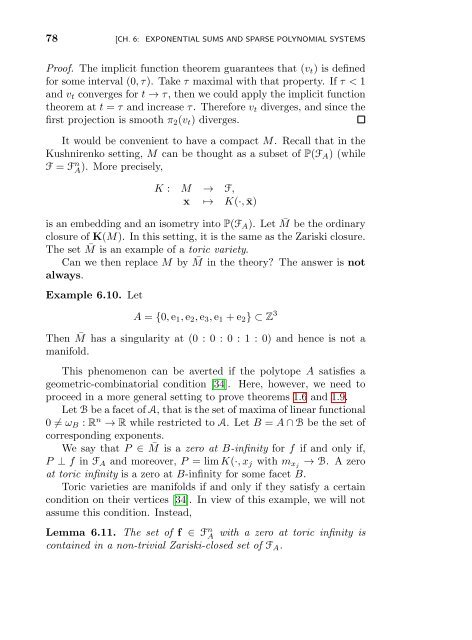Nonlinear Equations - UFRJ
Nonlinear Equations - UFRJ
Nonlinear Equations - UFRJ
You also want an ePaper? Increase the reach of your titles
YUMPU automatically turns print PDFs into web optimized ePapers that Google loves.
78 [CH. 6: EXPONENTIAL SUMS AND SPARSE POLYNOMIAL SYSTEMS<br />
Proof. The implicit function theorem guarantees that (v t ) is defined<br />
for some interval (0, τ). Take τ maximal with that property. If τ < 1<br />
and v t converges for t → τ, then we could apply the implicit function<br />
theorem at t = τ and increase τ. Therefore v t diverges, and since the<br />
first projection is smooth π 2 (v t ) diverges.<br />
It would be convenient to have a compact M. Recall that in the<br />
Kushnirenko setting, M can be thought as a subset of P(F A ) (while<br />
F = FA n ). More precisely,<br />
K : M → F,<br />
x ↦→ K(·, ¯x)<br />
is an embedding and an isometry into P(F A ). Let ¯M be the ordinary<br />
closure of K(M). In this setting, it is the same as the Zariski closure.<br />
The set ¯M is an example of a toric variety.<br />
Can we then replace M by ¯M in the theory? The answer is not<br />
always.<br />
Example 6.10. Let<br />
A = {0, e 1 , e 2 , e 3 , e 1 + e 2 } ⊂ Z 3<br />
Then ¯M has a singularity at (0 : 0 : 0 : 1 : 0) and hence is not a<br />
manifold.<br />
This phenomenon can be averted if the polytope A satisfies a<br />
geometric-combinatorial condition [34]. Here, however, we need to<br />
proceed in a more general setting to prove theorems 1.6 and 1.9.<br />
Let B be a facet of A, that is the set of maxima of linear functional<br />
0 ≠ ω B : R n → R while restricted to A. Let B = A ∩ B be the set of<br />
corresponding exponents.<br />
We say that P ∈ ¯M is a zero at B-infinity for f if and only if,<br />
P ⊥ f in F A and moreover, P = lim K(·, x j with m xj → B. A zero<br />
at toric infinity is a zero at B-infinity for some facet B.<br />
Toric varieties are manifolds if and only if they satisfy a certain<br />
condition on their vertices [34]. In view of this example, we will not<br />
assume this condition. Instead,<br />
Lemma 6.11. The set of f ∈ FA<br />
n with a zero at toric infinity is<br />
contained in a non-trivial Zariski-closed set of F A .

















